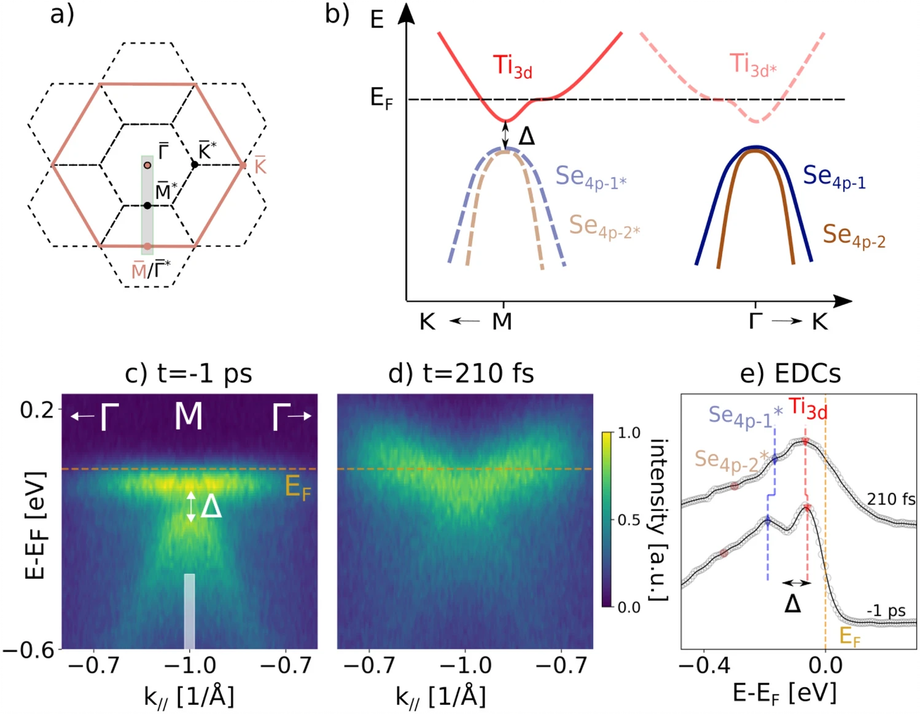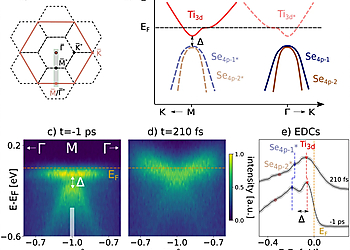Revealing the Order Parameter Dynamics of 1T-TiSe2 Following Optical Excitation
Result of the Month
The key to study this intriguing interplay of long- and short-range order and to understand the emergence of such correlated behavior is the order parameter. Indeed, having direct access to the quenching and re-formation dynamics of the order parameter during a photoinduced phase transition retains unique information on the mechanism behind the establishment of the new order. In this regard, time- and angle-resolved photoemission spectroscopy (tr-ARPES) yields a powerful way to access the formation and dynamics of the gap, given that it is the only technique that can directly monitor the onset of the order parameter with simultaneous momentum and time resolution. While signatures of the gap in the optical conductivity as well as the dynamics of the valence band at the Γ point have been studied before, in this study we directly follow the actual gap dynamics while also providing a direct comparison with all other relevant quantities, namely excited carriers and backfolded Se4p* band. We find that following photoexcitation, the gap undergoes only a partial quenching, up to 30%, of its equilibrium value (∼ 130 meV). This points to the existence of a pseudogap and to the presence of multiple coexisting mechanisms contributing to the CDW formation in TiSe2. Finally, we reveal that the folded Se4p* is mostly connected to only one of the components cautioning the common assumption that spectral weight dynamics is directly related to order parameter dynamics.

Figure Description: (a) First BZ in the high symmetry (orange) and CDW phase (black); the grey bar illustrates the cuts measured in the ARPES spectra in Γ-M-Γ direction. (b) Schematic band structure of the CDW state (adapted from Ref.15). (c) and (d) ARPES spectra of the M-point in equilibrium (c) and after excitation with 780 nm pump pulses at 80 μJ/cm2 fluence (d). For clarity the spectra are mirrored at the M point. The Fermi level is indicated by the dashed orange line. (e) EDCs taken at M corresponding to the spectra in panel (c) and (d). The region in momentum space over which the EDCs were integrated is shown by the white box in panel (c). Markers indicate the fitted peak positions of the Ti3d conduction band (red triangle) as well as the Se4p−1 (blue diamonds) and Se4p−2 valence bands (brown circles). Circles represents raw data and solid black lines represent the smoothed raw data using the Gaussian method (10 meV window).
Method
Time-resolved ARPES measurements were conducted at the Lawrence-Berkeley National Laboratory with 22.3 eV extreme-ultraviolet (XUV) femtosecond pulses. Photoelectrons are detected with a hemispherical electron analyzer (Scienta Omicron R4000).
In conclusion, this work places TiSe2 in the same context of other quantum materials where a pseudogap phase appears to precede long-range order. We find strong indications that the gap in TiSe2 is governed by two contributions, one caused by an excitonic condensate with long coherence length and one of Jahn–Teller character with short coherence length. The latter contribution can still give a well defined gap even after long range order was destroyed. In contrast, the well studied intensity of the folded Se4p* band gives access to predominantly only one of these contributions and originates mostly from the excitonic order. Thus, in summary our work exemplifies how valuable mechanistic insight can be gained by studying the order parameter and shines new light onto the complicated interplay of long and short range order in TiSe2, which is eventually the key for the understanding of doping or pressure induced superconductivity in this and other materials.
--
Authors
Maximilian Huber, Yi Lin, Nicholas Dale, Renee Sailus, Sefaattin Tongay, Robert A. Kaindl & Alessandra Lanzara
Institutes
Materials Science Division, Lawrence Berkeley National Laboratory, Berkeley, CA, 94720, USA
Maximilian Huber, Yi Lin, Nicholas Dale, Robert A. Kaindl & Alessandra Lanzara
Physics Department, University of California Berkeley, Berkeley, CA, 94720, USA
Nicholas Dale & Alessandra Lanzara
Materials Science and Engineering Department, Arizona State University, Phoenix, AZ, 85281, USA
Renee Sailus & Sefaattin Tongay
Department of Physics and CXFEL Labs, Arizona State University, Phoenix, AZ, 85287, USA
Robert A. Kaindl
Corresponding Author
Alessandra Lanzara
Publication
Huber, M., Lin, Y., Dale, N. et al. Revealing the order parameter dynamics of 1T-TiSe22 following optical excitation. Sci Rep 12, 15860 (2022). https://doi.org/10.1038/s41598-022-19319-w

